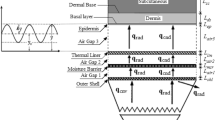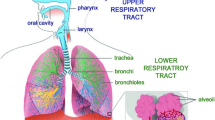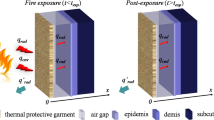Abstract
The pattern of the firefighter’s movement during fire exposure remarkably affects the protective performance of the firefighting suit. In addition, thermal energy transfer through the suit to the body, which determines the protective performance of the suit, takes place primarily by radiation heat transfer. Therefore, this study numerically investigates the influence of reducing the radiation heat transfer between the layers of the firefighting suit and from the suit to the body on the protective performance of the suit for different patterns of the firefighter’s movement. Specifically, the influence of reducing the emissivity (from 0.9 to 0.1) of the backside surface of each layer of the suit on the protective performance of the suit was explored for a variation in the frequency (from 0 rps to 4 rps) and amplitude (from 0.5 mm to 3 mm) of the periodic motion of the suit relative to the body. The results showed that reducing the emissivity of the backside surface of any of the layers of the suit improves the protective performance of the suit for high frequencies and low amplitudes of the motion. Moreover, reducing the emissivity of the backside surface of the thermal liner layer has the highest effect among the layers of the suit on the protective performance of the suit.











Similar content being viewed by others
Abbreviations
- c P :
-
Specific heat at constant pressure [J/kg K]
- c v :
-
Specific heat at constant volume [J/kg K]
- \(\hat e\) :
-
Unit vector in coordinate direction
- f :
-
Frequency [1/s]
- G :
-
Incident irradiation [W/m2]
- h :
-
Convection heat transfer coefficient [W/m2 K]
- I :
-
Irradiation intensity [W/m2]
- k :
-
Thermal conductivity [W/m K]
- P :
-
Pre-exponential factor [1/s]
- \(q^{\prime\prime}\) :
-
Heat flux [W/m2]
- \(\mathop{r}\limits^{\rightharpoonup}\) :
-
Position vector [m]
- R :
-
Universal gas constant [J/mol K]
- rps :
-
Revolutions per second
- s :
-
Geometric distance [m]
- \(\hat s\) :
-
Spatial unit vector
- T :
-
Temperature [K]
- t :
-
Time [s]
- y :
-
Vertical coordinate [m]
- \(\Omega\) :
-
Solid angle [sr]
- \(\varphi\) :
-
Skin damage quantitative coefficient
- \(\Delta E\) :
-
Skin activation energy [J/kmol]
- Δy :
-
Variation in the gap width [m]
- \(\varepsilon\) :
-
Emissivity
- \(\gamma\) :
-
Extinction coefficient [1/m]
- \(\kappa\) :
-
Absorption coefficient [1/m]
- \(\rho\) :
-
Density [kg/m3]
- \(\sigma\) :
-
Stefan–Boltzmann constant [5.67 × 10–8 W/m2 K4]
- \(\omega\) :
-
Blood perfusion rate [m3/s]
- air :
-
Air
- amb :
-
Ambient surroundings
- b :
-
Black body
- bl :
-
Human blood
- cr :
-
Body core
- ep :
-
Epidermis skin layer
- ds :
-
Dermis skin layers
- sc :
-
Subcutaneous skin layers
- exp :
-
Exposure
- fab :
-
Fabric
- g :
-
Hot gases
- hot :
-
Hot air
- R :
-
Radiation heat transfer
- shl :
-
Outer shell
- fl :
-
Flame
- o :
-
Initial
References
International Organization for Standardization (2016) ISO 9151 protective clothing against heat and flame-determination of heat transmission on exposure to flame. International Organization for Standardization, Geneva
American Society for Testing Materials (2000) ASTM F 1930-00 Standard Test Method For Evaluation Of Flame Resistant Clothing For Protection Against Flash Fire Simulations Using An Instrumented Thermal Manikin. West Conshohocken, PA
National Fire Protection Association (2018) NFPA 1971 Standard on Protective Ensembles for Structural Fire Fighting and Proximity Fire Fighting. Massachusetts, USA
Udayraj, Talukdar P, Das A, Alagirusamy R (2016) Heat and mass transfer through thermal protective clothing: a review. Int. J. Thermal Sciences 106:32–56
Ghazy A (2017) The thermal protective performance of firefighters’ clothing: the air gap between the clothing and the body. Heat Transfer Eng 38(10):975–986
Ghazy A (2020) On the protective performance of firefighters’ garments: air gaps between fabric layers. Fire Technol. J. 56(2):821–836
Elgafy A, Mishra S (2014) A heat transfer model for incorporating carbon foam fabrics in firefighter’s garment. Heat Mass Transfer 50:545–575
Udayraj, Talukdar P, Das A, Alagirusamy R (2017) Numerical modeling of heat transfer and fluid motion in air gap between clothing and human body: effect of air gap orientation and body movement. Int. J. Heat Mass Transfer 108:271–291
Ghazy A, Bergstrom DJ (2013) Numerical simulation of the influence of fabric’s motion on protective clothing performance during flash fire exposure. Heat Mass Transfer 49:775–788
Xin L, Li X, Li J (2014) A new approach to evaluate the effect of body motion on heat transfer of thermal protective clothing during flash fire exposure. Fibers Polym. 15(10):2225–2231
Ghazy A (2019) Influence of the fabric properties on the protective performance of flame resistant clothing during the body movement. Fire Technol. J. 55(3):713–728
Ghazy A, Bergstrom DJ (2012) Numerical simulation of heat transfer in firefighters’ protective clothing with multiple air gaps during flash fire exposure. Numer. Heat Transfer A 61:569–593
Ghazy A (2021) Evaluating the protective performance of municipal firefighting suits during firefighter’s motion under fire exposure. Fire Technol. J. 57(4):1827–1846
Xu Q, Li R, Shen L, Xu W, Wang J, Jiang Q, Zhang L, Fu F, Fu Y, Liu X (2019) Enhancing the surface affinity with silver nano-particles for antibacterial cotton fabric by coating carboxymethyl chitosan and L-cysteine. Appl. Surf. Sci. 497:143673
Rezaei F, Maleknia L, Valipour P, Fard GC (2016) Improvement properties of nylon fabric by corona pre-treatment and nano coating. J. Textile Inst. 107(10):1223–1231
Henriques FC Jr, Moritz AR (1947) Studies of thermal injuries I: the conduction of heat to and through skin and the temperatures attained therein. A theoretical and experimental investigation. Am. J. Pathol. 23:531–549
Chai JC, Patankar SV (2000) Finite-volume method for radiation heat transfer, advances. In: Minkowycz WJ, Sparrow EM (eds) Numerical heat transfer. Taylor & Francis, New York
Mercer GN, Sidhu HS (2008) Mathematical modeling of the effect of fire exposure on a new type of protective clothing. ANZIAM 49:C289–C305
Author information
Authors and Affiliations
Corresponding author
Additional information
Publisher's Note
Springer Nature remains neutral with regard to jurisdictional claims in published maps and institutional affiliations.
Rights and permissions
About this article
Cite this article
Ghazy, A. On the Performance of Firefighting Suits Under Different Patterns of Firefighter’s Movement: Radiation Heat Transfer Between Layers of the Suit. Fire Technol 58, 2055–2076 (2022). https://doi.org/10.1007/s10694-022-01239-w
Received:
Accepted:
Published:
Issue Date:
DOI: https://doi.org/10.1007/s10694-022-01239-w




